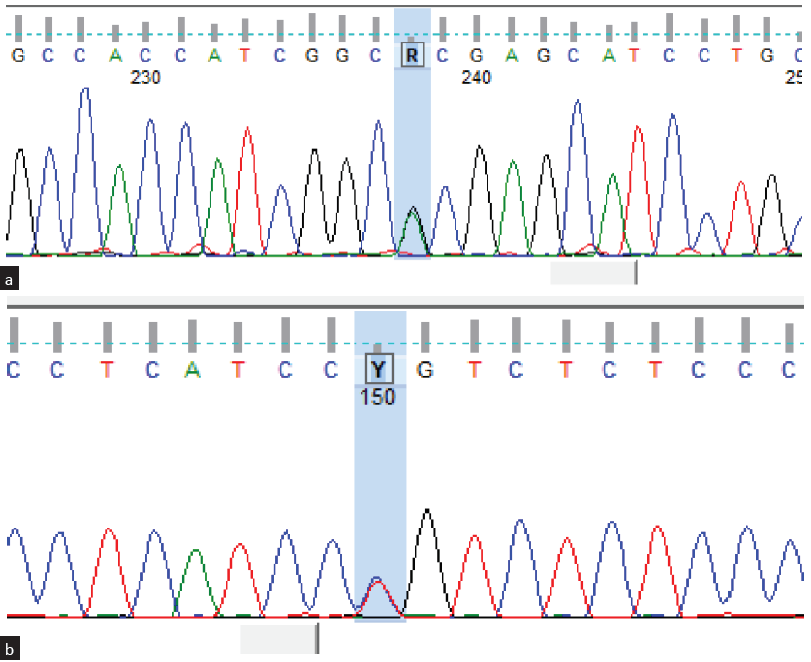Translate this page into:
Novel Variations in KIRREL1 Gene and Infantile Onset Nephrotic Syndrome
Corresponding author: Nitish Kumar, Division of Pediatric Nephrology, Department of Pediatrics, Institute of Medical Sciences, Banaras Hindu University, Varanasi, India. Email: doctornitishkumar@gmail.com
-
Received: ,
Accepted: ,
How to cite this article: Abhinay A, Agarwal A, Singh A, Kumar N. Novel Variations in KIRREL1 Gene and Infantile Onset Nephrotic Syndrome. Indian J Nephrol. 2024;34:547-8. doi: 10.25259/IJN_55_2024
Dear Editor,
More than 58 monogenic genes associated with steroid resistant nephrotic syndrome (SRNS) have been described to date.1 Kin of IRRE-Like protein 1 (KIRREL1) has been described as an nephrotic syndrome type 1 (NPHS1) like Ig superfamily cell adhesion molecule.2 We report two heterozygous missense mutations in the KIRREL1 gene leading to SRNS in a child with infantile nephrotic syndrome.
A 2-year-old male, a case of infantile-onset SRNS born out of a nonconsanguineous marriage, diagnosed at the age of 11 months was reported positive for the KIRREL1 gene mutation on exons 12 and 15. A mislocalization of both KIRREL1 mutants c.1513G>A (p.Ala505Thr) and c.1918C>T (p.Arg640Cys) was noted, which have not been reported previously as pathogenic variants. This was also confirmed by Sanger sequencing, as seen in Figure 1. Given the condition we found in our case of two different mutations in the same gene is classified as compound heterozygosity, it is difficult to ascertain any definite relationship between our findings and the clinical presentation. The child was started on Tacrolimus and ACE-I inhibitors and discharged. On 1-year follow-up, the child is in complete remission. There were no extrarenal manifestations or syndromic features in the child.

- (a) Sanger sequencing data (electropherogram) shows a nucleotide change at c.1513G>A (p.Ala505Thr) in the KIRREL1 gene. (b) Sanger sequencing data (electropherogram) shows a nucleotide change at c.1918C>T (p.Arg640Cys) in the KIRREL1 gene.
A direct interaction between NPHS1 and KIRREL1 because of their co-localization at the slit diaphragm has been described.3 KIRREL1 is necessary for the rearrangement of the actin cytoskeleton of the slit diaphragm.4 Previously, mutations in the KIRREL1 gene from two unrelated families were reported in children who presented at the ages of 5 and 14 with SRNS, respectively, which were p.Arg440Cys and p.Ser573Leu.1 Patients with this mutation achieved complete remission upon treatments with tacrolimus, CCB, and ACE-I; however, they can progress to CKD.1 For genotype-treatment relationships, further research is needed.
Acknowledgement
We thank all the residents and staff involved in the care of this patient.
Declaration of patient consent
The authors certify that they have obtained all appropriate patient consent.
Conflicts of interest
There no conflicts of interest.
References
- Mutations in KIRREL1, a slit diaphragm component, cause steroid-resistant nephrotic syndrome. Kidney Int. 2019;96:883-9.
- [CrossRef] [PubMed] [PubMed Central] [Google Scholar]
- NEPH1 defines a novel family of Podocin interacting proteins. FASEB J. 2003;17:115-7.
- [CrossRef] [PubMed] [Google Scholar]
- Nephrin and neph1 co-localize at the podocyte foot process intercellular junction and form cis hetero-oligomers. J Biol Chem. 2003;278:19266-71.
- [CrossRef] [PubMed] [Google Scholar]
- Neph1, a component of the kidney slit diaphragm, is tyrosine-phosphorylated by the src family tyrosine kinase and modulates intracellular signaling by binding to grb2. J Biol Chem. 2008;283:9177-86.
- [CrossRef] [PubMed] [PubMed Central] [Google Scholar]







